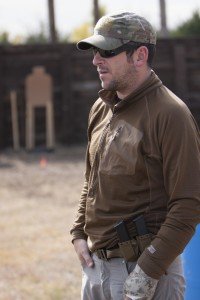
The author about to shoot a one-day handgun course just three days after breaking his hand. Notice the Ares Gear Ranger belt and tactical Coban wrapped cast.
By Daniel Shaw
A few months ago, I broke my fifth finger metacarpal while defending a bus full of cute puppies from an aggressive hoard of ninjas. The doctor put my arm in a half cast sort of thing that completely took my arm out of action for over a month. Fortunately I am right handed and it was my left arm that was damaged by the ninja blocking my quick jab with his face. All kidding aside, I did break my hand and had to wear the cast for over a month. Before the injury, I had, for many years, trained one-handed techniques, but I never dedicated full range sessions to it. While I was not as skilled using one hand as I am using two to run a handgun, I already had the basics in one of my brain’s filing cabinets and had spent hours on the most common of one-hand problem solving techniques, such as clearing clothing, drawing, reloading and stoppage clearance. For the next few days, I spent an hour so each day working on increasing my proficiency with only one hand available, and here’s what I learned.
It occurred to me that I am not the first person to have “life” happen to me and create additional problems. Injuring a hand or arm in the middle of a fight for your life is certainly a possibility, but it’s also a possibility that your arm could be injured prior to a defensive use of force situation. It could be that you are holding a child, pushing your spouse toward cover or an exit or simply continuing to grasp whatever is in your hand at the onset of the confrontation, as we see law enforcement officers do with clip boards very often in dash cam video.
Quick scenario, you are walking through the food court at the local mall with your wife and child on a Saturday afternoon. Of course you are carrying bags that have half naked men pictured on them, but that is another article. Gunfire begins to erupt behind you; people are running in practically every direction as you observe the shooter. While yelling for your spouse to grab the kids and get to an exit, you decide that your best action to increase the odds of your own and your loved ones’ survival is to draw your handgun and stop the active murderer immediately. Two to four seconds have passed since the first shot. Your spouse is not only holding on to a child’s arm, he or she is also holding on to your arm with a death grip attempting to drag you toward the exit. At least for right now, you only have one hand free to access your handgun and put bullets on the bad guy.

By sweeping backward and getting a thumb under the shirt, the author is able to access the handgun quickly and efficiently. The holster shown is the Haley Strategic Partners INCOG by G-Code.
Obviously, the aforementioned hypothetical situation is an extreme case or even a worst case, considering the number of innocent bystanders and countless other complexities the situation presents. The act of clearing clothing to access the firearm is in itself a complex task if the armed citizen has not trained to draw and accurately engage a threat with one hand. Granted, in the discussed situation, the armed citizen may only be forced to begin the process of drawing the firearm with one hand and have freed his or her arm part of the way through the process. When you must draw your handgun from concealment with one hand, it should not be the first time you have drawn your handgun from concealment.
There are many considerations that should be thought about when it comes to accessing and employing a firearm with one hand, and we will briefly discuss a few by asking ourselves questions.
Do I carry in a location on my body that could impair my ability to clear clothing and access the handgun? Is there a better location or carry method that would increase my ability to fight in a variety of situations? Do my belt and holster simply hold my gun and my pants up, or do they keep the gun firmly where it should be while offering a rigid surface to manipulate the firearm? Can I manipulate my slide using my sights or a surface on my handgun during one-hand stoppage clearances or reloads?
Most of the above questions can be assessed in dry practice with an unloaded and double-checked handgun, but time should certainly be spent in live fire, while working through problems with one hand, just as you would train for those issues with two hands. While training is paramount in my opinion, efficient support gear can make a difference.
The Handgun
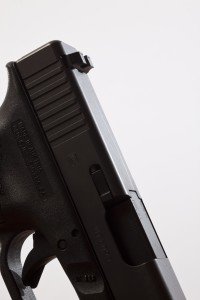
A shot of the I.C.E. CLAW Emergency Manipulation Sights by Ameriglo. The curved leading edge of the sights is designed to aid one-hand manipulations, a task that they certainly accomplish.
To me, a good defensive handgun is one that is not prone to stoppages or malfunctions and provides consistent, accurate fire every time I press the trigger. Since this article is about fighting with one hand, the gun needs to support one-handed manipulation either through its design or aftermarket products, such as sights that have a steep enough angle to catch on a belt, holster, shoe, table top etc.
There are plenty of sights that can be used to manipulate a slide of a handgun. For almost a year now, I have been using the I.C.E CLAW Emergency Manipulation Sights made by Ameriglo and have been very impressed by their performance. The sights feature a curved leading edge that is designed to catch on objects when working the slide with one hand. My favorite part about the CLAW EMS is the price. They can be had for $24.00 for just the rear or $40 for a front and rear set. Prices vary slightly depending on the gun they are made for, but they are available for Glocks, S&W M&P series including the Shield and Springfield Armory XD’s.
The Belt
There are a lot of good gun belt options out there these days, but they are not usually at your local mall or Wal-Mart. The belt should be one that has strength and rigidity in it to insure that the holster stays where it should while distributing the weight of the gun on the hips or waist of the wearer. When people tell me that they hate holster x and didn’t care for holster Y, my first question is – what kind of belt do you wear? Thanks for asking. Every day of my life, I wear either a Ranger Belt or Aegis Enhanced Belt made by Ares Gear where the motto is “Stiffer is Better.”
Both the Aegis and Ranger belts are 1.5” and are made with two layers of proprietary scuba webbing. They come in a variety of colors so they look great while performing effectively. Until I picked up the new Aegis Enhanced Belt, I wore my Ranger Belt every day for over two years and, other than a scratched up Cobra Buckle, the belt is as stiff and looks as good as new.
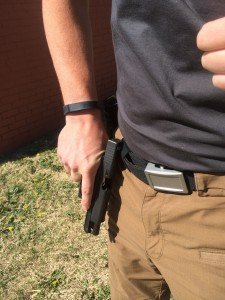
When a stiff surface is needed to rack a slide on a handgun, why not have one that also distributes the weight of the gun evenly while holding your pants up in style. The belt shown is the Ares Gear Aegis Enhanced belt.
The Holster
Since I am of average build at 5’10” and 180 pounds, I carry inside the waistband 70% of the time. The other 30% is dead of winter, with a big jacket concealing an outside the waistband holster. There are a plethora of good options out there in holster land, and I really don’t have one go-to holster that I use all the time. For outside the waistband, I have had some great holsters made by “the guy down the road” who makes custom kydex holsters, and I have had great experiences with companies like Raven Concealment and G-Code Holsters. Since I carry IWB most of the time, I will focus on those.
I have used leather/kydex hybrid holsters from Concealment Solutions, Crossbreed and Comptac for years and have found them to be very comfortable and solidly performing holsters, but I find that in the warmer months I don’t care for the large leather surface against my skin. I spent the last eight months or so carrying in a Haley Strategic Partners INCOG made by G-Code. The INCOG is hard to beat in its customization and conceal ability from appendix carry to carrying at around four o’clock on the waist/clock system scale. All of the holsters mentioned will support slide manipulation and will hold up to a tremendous amount of abuse.
As I previously stated, training is paramount, and all the latest and cool gear out there will not do you any good if you do not know how to use it properly. If you have been thinking about filling gaps in your training or this article has brought a possible training deficiency to mind, I encourage you to find a reputable trainer and get in a class before going out and buying new belts, holsters or sights. Take notes during the class and list what problems you encounter during the days of training. A good instructor will be able to teach you to work through those problems, and in the process you will likely see how some of the support gear mentioned in this article can help you live a safer life.
- The author using the holster technique to conduct a one-handed speed reload.
- An aggressive position at full arm extension helps to mitigate the effects of repeated recoil when shooting one handed.
- The author setting up a double feed for a stoppage clearance drill. Clearing a double feed one-handed can be done in similar fashion as reloading one-handed. The double feed just adds a few more steps.
- An example of a rear sight that is not ideal for use in one-hand manipulations. There are other parts of the gun that can be used when the sights are not optimal, such as the rear portion of the ejection port.
- The CLAW EMS doing its job by gaining a sure purchase on a G-Code OSH belt slide RTI. As a rule, I always try to break things that are part of my everyday carry system.
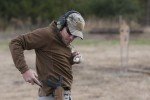
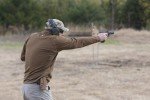
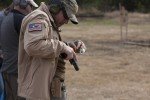
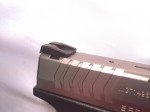
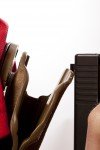
A compact, double action revolver would be a very good alternative to an auto with its racking problems. It should have been included for review. By the way, I have only one useful arm and have dealt with this situation for years. Good article and glad to see some attention being paid to the problems faced by others in this situation.
Fractures of the fifth metacarpal are usually caused by hitting something solid–they are often called a ‘boxer’s fracture.’ What did you hit?
Fractures of the fifth metacarpal are usually caused by hitting something solid–often called a ‘boxer’s fracture.’ What did you hit?
I think “horde” was misspelled, but that opening line was amazing!
Agree on all counts!